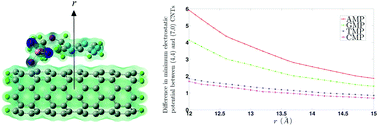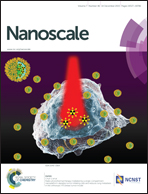Electrostatics of DNA nucleotide–carbon nanotube hybrids evaluated from QM:MM simulations†
Abstract
Biomolecule-functionalized carbon nanotubes (CNTs) have been studied vastly in recent years due to their potential applications for instance in cancer detection, purification and separation of CNTs, and nanoelectronics. Studying the electrostatic potential generated by a biomolecule–CNT hybrid is important in predicting its interactions with the surrounding environment such as charged particles and surfaces. In this paper, we performed atomistic simulations using a QM:MM approach to evaluate the electrostatic potential and charge transfer for a hybrid structure formed by a DNA nucleotide and a CNT in solution. Four types of DNA nucleotides and two CNTs with chiralities of (4,4) and (7,0) were considered. The types of nucleotides and CNTs were both found to play important roles in the electrostatic potential and charge transfer of the hybrid. At the same distance from the CNT axis, the electrostatic potential for the nucleotide–(4,4) CNT hybrids was found to be stronger compared with that for the nucleotide–(7,0) CNT hybrids. Higher electric charge was also shown to be transferred from the DNA nucleotides to the (7,0) CNT compared with the (4,4) CNT. These results correlate with the previous finding that the nucleotides bound more tightly to the (7,0) CNT compared with the (4,4) CNT.


 Please wait while we load your content...
Please wait while we load your content...